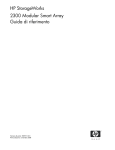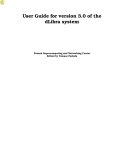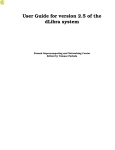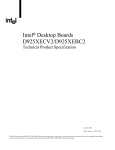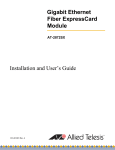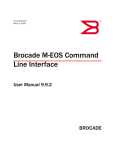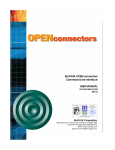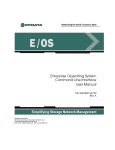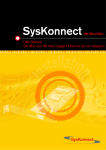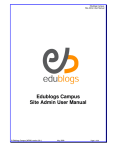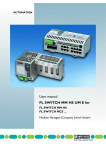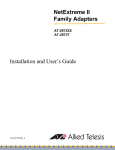Download Eclipse SAN Routers SRN Rev. B
Transcript
Copyright © 2006 McDATA Corporation All rights reserved. Eclipse SAN Routers Enterprise/ Operating System internetworking (E/OSi) Version 04.07.00 SANvergence Manager 04.07.00 Release Notes P/N 958-000364-470 Rev D 05/24/06 Copyright © 2006 McDATA Corporation. All rights reserved. These release notes describe changes to Eclipse SAN Router firmware, called Enterprise Operating System Internetworking (E/OSi) version 04.07.00. NOTE: To improve readability, the remainder of this document refers to E/OSi versions without the leading zeros. In other words, E/OSi version 04.07.00 is referenced as version 4.7. Section Page Applicable Products 2 What’s New in This Release 3 Features Supported (2640 SAN Router) 9 Not Supported in this Release 10 E_Port Compatibility 11 1 Applicable Products Section Page Upgrade and Downgrade Considerations 12 Prerequisites for Installing and Using this Release 13 Product Operational Notes 13 Minor Code Fixes and Enhancements in this Release 23 Outstanding Known Issues in this Release 25 Scalability Metrics 29 Microsoft iSCSI Initiators Tested for this Release 31 Standards Compliance 34 Related Documentation 37 Previous Releases 38 Applicable Products The following products are supported in this release: 2 • Eclipse 2640 and 1620 SAN Routers • SANvergence Manager Eclipse SAN Routers Release Notes P/N 958-000364-470 Rev D What’s New in This Release What’s New in This Release Storage Optimized TCP Features Options were added and modified in the Element Manager and CLI interfaces to better handle out-of-order packets and congested networks. Element Manager CLI The Advanced TCP dialog box was modified to add the Storage Optimized TCP Features, which can be applied to both iFCP and iSCSI. The following lists all the Storage Optimized TCP Features added to the Advanced TCP dialog box. • Smaller CWND Reduction in Fast Recover - Enable to allow the SAN Router to respond more slowly to congestion events. • Quick Start - Can enable to use a larger initial value for the congestion window at the beginning of TCP Slow Starts, and increase the congestion window size more rapidly. • Reduced Slow Start Timeout - Enable to reduce the minimum Slow Start timeout from 500 msec to 150 msec. • Disable Standard Congestion Avoidance - Disables the slow growth mode of the SAN Router's congestion window that occurs in the standard TCP stack once a congestion event is detected. • Reorder Resistance - Enable to increase the number of duplicate ACKs required to trigger a Fast Retransmit or Fast Recovery. • Threshold field - Enter a number for duplicate ACKs required to trigger Fast Retransmit or Fast Recovery. These parameters were added to the set port tcp adv command to provide Storage Optimized TCP functions in CLI. Refer to comparable options under Element Manager, page 3 for descriptions of functions. • smaller-cwnd <off|on> • quick-start <off|on> • redslowstart-timeout <off|on> • disablecongestavoid <off|on> • reorder-resistance <off|on> Eclipse SAN Routers Release Notes P/N 958-000364-470 Rev D 3 What’s New in This Release • redslowstart-timeout <off|on> • reorder-threshold<value> Hardware-Based Compression Hardware Compression is added to the Compression Level drop-down list on the iFCP tab of the Advanced TCP Configuration dialog box. When selected, all transmitted data is compressed using the hardware feature in the SAN router. This is the recommended setting if the remote destination also supports hardware compression. Fabric Binding CLI commands are added and SANvergence Manager is modified to support Fabric Binding. This allows a SAN Router to connect to a fabric with SANtegrity Fabric Binding enabled. • SANvergence Manager - A new Fabric Binding tab is added to the Fabric Configuration dialog box. Note that this tab is grayed out if Brocade is selected as the Interconnect Mode in the SAN Router's SANvergence Manager | mSAN Configuration | Fabric Configuration. • CLI - The following commands were added: — set port rport fabricbinding — show port rport fabricbinding — delete port rport fabricbinding FastWrite Options New selections are included on the iFCP tab of the Advanced TCP Configuration dialog box of the Element Manager to optimize the Fast Write option 4 • XFER_RDY limit (transfer ready limit) specifies the number of XFER_RDY commands that may be issued early by the SAN Router to avoid round-trip delays. The limit is applied separately to each Fibre Channel login session. • XFER_RDY Windowing (transfer ready windowing). When selected, the configurable XFER-RDY limit is treated as a moving window of consecutive XFER_RDYs that may be issued early by Eclipse SAN Routers Release Notes P/N 958-000364-470 Rev D What’s New in This Release the SAN Router. If not selected, the XFER_READY limit is simply the total number of XFER-RDY commands that can be simultaneously outstanding for each login session. • Remote Buffer Management. When selected, the local SAN Router limits the amount of buffer memory used in the remote SAN Router by limiting the amount of data requested by the local SAN Router and sent to the remote SAN Router without a XFER_RDY from the target device. Users can specify the maximum amount of buffered data, in Kilobytes, which is available in a single pool for all Fibre Channel login sessions. Transfer Buffer Management A selection on the iFCP tab of the Advanced TCP Configuration dialog box of the Element Manager allows users to enter the amount of Fibre Channel receive buffers that an iFCP port has for receiving the Fibre Channel frames forwarded from a fabric. Additional parameters are added to the set port tcp adv CLI command to configure this also. These include xmit-bufcount and xmit-buffering. Removal of mFCP Support for 2640 Metro Fibre Channel Protocol (mFCP) connections are not supported in this release for the Eclipse 2640 SAN Router. The Eclipse 1620 SAN Router does not support mFCP. As a consequence, support is also not available in the Element Manager and CLI for VLANs, Spanning Tree options, and manual link aggregation on mFCP ports. Telnet Access The ability to disable and launch Telnet access has been added to CLI, the Element Manager, and SANvergence Manager. Disable Telnet Launch Telent Options were added to the following to enable and disable remote access through Telnet. • System Operations dialog box in the Element Manager. • New CLI command: set system Telnet enable/disable. A Telnet icon was added to the main SANvergence Manager window to launch Telnet access. Eclipse SAN Routers Release Notes P/N 958-000364-470 Rev D 5 What’s New in This Release Remote Connection Statistics Two new columns are added to the Element Manager Remote Connection Statistics dialog box to select the remote connections to be plotted in the Xmt and Rcv Traffic graphs and in other graphs in the dialog box. When there are many remote connections, this improves performance, makes the graphs less cluttered, and avoids color conflicts. Increased BB Credits Allowed BB Credits on Eclipse 1620 and 2640 Fibre Channel ports was increased from 16 to 28. System LED Changes The blinking rates of the “Sys” LED on the Eclipse 2640 SAN Router was changed as follows: • LED turns solid amber at Initial Power-On. • LED turns amber during booting and initialization. The blink rate alternates on and off at a 2Hz rate with a 50% duty cycle (250msec on, 250msec off). • LED blinks green at a slower rate during normal operation. The blink rate has a short duration of illumination to attract attention.5Hz rate, 12.5% duty cycle (250msec on and 1750msec off). Zone Export Moved to SANvergence Manager Zone export configuration for iFCP Remote Connection has been moved from the Element Manager to the SANvergence Manager application. A new Export Zones dialog box is available through the Actions menu in the mSAN Configuration window. The Add/Edit Remote Connection dialog box in the Element Manager is now read only and does not contain the export zone function. 6 Eclipse SAN Routers Release Notes P/N 958-000364-470 Rev D What’s New in This Release Login Banner A new CLI command (set banner) and a new tab was added to the Element Manager System Properties dialog box to customize a login banner. In the Element Manager, this text displays in the HTML launch page above the login dialog box. In CLI, this text displays when the user logs in. New CLI Commands • set routerzone activate • set routerzone discard-unsaved • set banner • reset banner • show banner • set port rport fabricbinding • show port rport fabricbinding • delete port rport fabricbinding • show ip route Modified CLI Commands These CLI commands were modified, mostly for Storage-Optimized TCP and FastWrite features. • set routerzone • delete routerzone • set system telnet enable/disable • set port tcp adv • set port rport • set port rport fabric • show port rport • delete port rport • set port general type Eclipse SAN Routers Release Notes P/N 958-000364-470 Rev D 7 What’s New in This Release • set port general tcptype • set port iscsi Additional Changes in SANvergence Manager NAT Support NAT is a method of connecting multiple computers to the Internet (or any other IP network) using one IP address. This is done by multiplexing traffic from the internal network and presenting it to the Internet as if it was coming from a single computer having only one IP address. Network Address Translation (NAT) support is added to SANvergence Manager to support this network configuration. After the user logs in to the mSAN through SANvergence Manager, SANvergence Manager matches the IP address of the source in the SNMP response header with the switch address. If there is a mismatch, then SANvergence Manager treats this as a NAT environment. If the SNS role has been set to server, then the SANvergence Manager retrieves all the SNS information and populates the SAN Routers & FC Switches table in the main SANvergence Manager window. Although the real IP address for the secondary SAN Router still displays in the SAN Routers & FC Switches table, the user can enter the NAT IP address for the router through the mSAN Properties dialog box. For all subsequent queries, the NAT IP addresses are used instead of the real ones. When SANvergence Manager exits, the mapping of NAT'd <-> Real IP addresses information is saved. User Authentication A User Login dialog box now appears when launching SANvergence Manager. Users can log in with an Administrator or Operator password. When logged in as an Administrator, the user has modify privileges; when logged in as Operator, the user has read-only privileges. Zone Bandwidth Levels The Zone Properties dialog box allows traffic shaping values to be set in the range of 150 to 1000000 Kbits/sec in 1K increments. The Zone Bandwidth feature can be applied to iFCP traffic only. Non-Disruptive Fabric Build Feature In previous E/OSi releases, whenever a fabric reconfiguration (non-disruptive build fabric) occurs in a fabric connected to an 8 Eclipse SAN Routers Release Notes P/N 958-000364-470 Rev D Features Supported (2640 SAN Router) Eclipse SAN Router, depending on the topology, any interfabric I/Os going from that fabric through the SAN Router will be disrupted. With E/OSi 4.7, the following events will be handled non-disruptively: • Addition or removal of a downstream Fibre Channel switch. • Addition of a non-Fabric Manager ISL on the SAN Router The following events will still be disruptive: • Removal of a Fabric Manager-ISL on the SAN Router. Code Fixes and Enhancements Code fixes and enhancements have been included in this release. Refer to Minor Code Fixes and Enhancements in this Release, page 23. Features Supported (2640 SAN Router) • mSAN Routing - E/OSi 4.7 and the 2640 SAN Router supports Fibre Channel inter-fabric routing in the data center. • iSAN Routing - Supports routing over iFCP over distance. • iSCSI connections. • Active zone set creation. If there is no existing active zone set in the fabric, one will be created automatically. • Support for 2 Gbps on any port configured for Fibre Channel. • CLI and SNMP support for Eclipse 2640 • Network Time Protocol (NTP) • Non-principal switch. • McDATA Fabric (Native) mode. • Brocade (Native) mode. • Open Fabric (Interoperable) mode. • Hardware Compression support over iFCP connection Eclipse SAN Routers Release Notes P/N 958-000364-470 Rev D 9 Not Supported in this Release Not Supported in this Release 10 • iSNS (Internet Storage Name Server) is not supported in this release. • Zoning based on physical ports within zones exported over iFCP • Metro Fibre Channel Protocol (mFCP) support on GE ports. • iFCP and iSCSI to co-exist on the same TCP port is not supported in this release. Eclipse SAN Routers Release Notes P/N 958-000364-470 Rev D E_Port Compatibility E_Port Compatibility The following table shows E/OSi 4.7 support for attaching Fibre Channel switch E_Ports to the Eclipse 2640 and 1620 SAN Routers. The Fibre Channel switches must be operating in McDATA Fabric 1.0 or Open Fabric 1.0 interoperating modes. Table 1 E_Port Compatibility with E/OSi 4.7 for all SAN Routers Interconnect Mode FC Switch Release McDATA Fabric 1.0 Open Fabric 1.0 Sphereon 3016 E/OS 5.x, 7.x, 8.x X X Sphereon 3216 E/OS 5.x, 7.x, 8.x X X Sphereon 3032 E/OS 5.x, 7.x, 8.x X X Sphereon 3232 E/OS 5.x, 7.x, 8.x X X Sphereon 4300 E/OS 7.x, 8.x X X Sphereon 4500 E/OS 5.x, 7.x, 8.x X X Sphereon 4700 E/OS 8.0 X X Sphereon 4400 E/OS 8.0 X X Intrepid 6064 E/OS 5.x, 7.x, 8.x X X Intrepid 6140 E/OS 5.x, 7.x, 8.x X X Intrepid 10000* E/OSn 6.x X X Brocade 3900 4.1.2a.b. e; 4.2.0b; 4.4.0b X X** Brocade 3200/3800 3.1.1a,b,c; 3.1.2a; 3.2.0 X X Brocade 3250/(3850) 4.2.0b; 4.4.0b X X** Brocade 2400 2.6.1a,b,c; 2.6.2b X X Brocade 12000 4.1.2b; 4.2.0b X X Brocade 4100/(24000) 4.4.0b X X** Eclipse SAN Routers Release Notes Brocade Native Mode P/N 958-000364-470 Rev D 11 Upgrade and Downgrade Considerations Table 1 E_Port Compatibility with E/OSi 4.7 for all SAN Routers QLogic SANBox2 3.0, 4.0, 4.1, 4.2.0.18 X QLogic SANBox 5200 5.0.0.27 X QLogic Sb3050-08A-EB 4.0.2.4-0 X IBM Blade Server IBM QLogic 4.1, 5.2 Cisco 9509 1.3.5, 2.0.1b, 2.0.3 X FC 9000 5.0 X CNT UMD 1.1.1.1.5 X X X Bold text of firmware versions indicate “Tested & Supported” with E/OSi 04.07.00. Regular text of Switch firmware versions indicate “Supported” with E/OSi 04.07.00. * Routing between two or more I-10K directors as well as routing between partitions within one I-10K. ** Brocade Native Interconnect Mode is supported with Brocade version 4.4.0b. Upgrade and Downgrade Considerations 12 • You can transfer the Sanvergence Manager 4.4.1 file containing the discovered mSAN IDs, user-defined labels, and other information to version 4.7. Refer to instructions on reusing the saved mSAN List in chapter 2 of the McDATA SANvergence Manager User Manual (620-000189). • SANvergence Manager versions before 4.7 are not compatible with a E/OS versions at a higher release level. For example, SANvergence Manager 4.4.1 cannot be used to manage the Eclipse 2640 SAN Router running E/OSi 4.7. • If using E/OSi 4.4 or earlier, we recommend that you only upgrade to SANvergence Manager 4.6 if you are managing a 2640 SAN Router. If you choose to use SANvergence Manager 4.6 to manage SAN Routers that are operating with E/OSi 4.4 or earlier, there will be discrepancies in the terminology used between SANvergence Manager and the product's Element Manager or CLI. Refer to the E/OS 4.6 Software Release Notes (P/N 958-000364-460) for details. Eclipse SAN Routers Release Notes P/N 958-000364-470 Rev D Prerequisites for Installing and Using this Release • SANvergence Manager produces an exception pop-up message after downgrading to the Base bundle from the Full Feature bundle when Fabric Binding is enabled on the SAN Router. As a work around, reset the SAN Router configuration values to factory-default after downgrade. • If running E/OSi 4.7 with Fabric Binding enabled and you downgrade to E/OSi 4.6, the fabric will segment because E/OSi 4.6 does not support Fabric Binding. Prerequisites for Installing and Using this Release • DirectX 9.0b or later must be installed on the management workstation (Windows operating system) if additional software programs, such as EFCM or PC Anywhere, are coresident with SANvergence Manager. Product Operational Notes The following table provides important information on behavior, operating characteristics, and use of the Eclipse SAN Routers. Table 2 Product Operational Notes Note Category For fast write to function, all the SAN Routers must be running 4.5.1, 4.6.2 or 4.7.0. Third Party Interoperability When connecting a Qlogic switch to an Eclipse Router R_Port in Interop Mode, set the zoning Default Visibility to None. Third Party Interoperability Enable the Brocade switch port as an E_Port when connecting it to a SAN Router. Third Party Interoperability Set the Brocade switch port speed to operate at 1 Gbps when connecting to an Eclipse 1620 R_Port. Third Party Interoperability In the following configuration, after several cable pull operations at the R_Port, the Brocade 4100 will drop the last two FC frames of an I/O coming from an MS iSCSI Initiator, which causes the MS iSCSI to encounter the I/O timeout condition. Configuration: A Symmetric connects to a Brocade 4100, the Brocade 4100 connects to SAN Router R_Port, and an MS iSCSI Initiator connects to SAN Router iSCSI port. Workaround: If the application running ion the MS iSCSI Initiator is designed to retry based on an I/O timeout condition, then the I/O will eventually recover. Third Party Interoperability Eclipse SAN Routers Release Notes P/N 958-000364-470 Rev D 13 Product Operational Notes Table 2 14 Product Operational Notes (continued) Note Category R_Port connected to a standalone Brocade 2800 is isolated, No Response. Analysis concludes that the Brocade 2800 does not respond to the zoning protocol correctly when large zone sets are configured. Specifically, while the Brocade 2800 is performing a “zone save,” it cannot accept another zone update. For example, the Brocade 2800 accepts a zone update request instead of rejecting it. This condition could occur in fabrics with or without SAN Routers. Workaround: The customer should follow Brocade guidelines to determine an effective zoning configuration for SAN environments which include Brocade 2800 FC Switches: • The zoning database size for SilkWorm 2000 series, 3200, and 3800 switches is 96 KB and 128 KB for SilkWorm 3016, 3250, 3850, 3900, 12000, and 24000 switches. To check the size of a zone database, use the command cfgSize. • A switch with a zoning database size limit of 96 KB limits the size of the zoning database for the whole fabric - even if a SilkWorm 3016, 3250, 3850, 3900, 12000, or 24000 switch is present in the fabric. Third Party Interoperability QLogic Switch failed to return all devices in a GID_PT. Specifically, the QLogic switch did not return information to an initiator (Emulex HBA) about devices in an Eclipse domain on Eclipse 1620 and 2640 SAN Routers. The issue has been determined to be a QLogic problem with Model 5200 running version 5.2.0.32 firmware in Standard Interop Mode. Workaround: Customer should unplug/replug the HBA connection into the QLogic switch that cannot discover its assigned target port(s). Third Party Interoperability In 4.7, iFCP port s now provide the hardware-based compression feature. Due to the hardware-based compression support, if a user changes the TCP port type from iSCSI to iFCP (or change from iFCP to iSCSI), additional action is required to activate the TCP port with correct port type operation with the new port type. For the 1620, once a user changes the TCP port type, a reboot of the 1620 is required. For the 2640, once user changes the TCP port type, a TCP port reset is required. Installation and Configuration Trivial file transfer protocol (TFTP) may not work reliably while upgrading the firmware on the SAN Router. If this occurs, try the upgrade again with the per-packet timeout on the TFTP server set to less than 5 seconds. Installation and Configuration Eclipse SAN Routers Release Notes P/N 958-000364-470 Rev D Product Operational Notes Table 2 Product Operational Notes (continued) Note Category SoIP Zones are automatically updated by the SAN Router and pushed to the attached FC fabric when the SAN Router Zone Policy is “Append SAN Router Zones”. Customer could experience situations where SAN Router zones disappear and reappear if modifying SoIP Zones through another management application. Workaround: This condition is not a problem, but rather the working implementation. The SAN Router believes that all SoIP Zones are under the ownership of the SAN Router and not the fabric. If a customer performs a change to an SoIP Zone using a management application other than SANvergence Manager (SAN Router's proprietary management), when the customer clicks Apply to enable the change, the fabric pushes the zone up to the SAN Router. However, because it's a SAN Router-owned Zone, the SAN Router will re-append the original “owned” SoIP Zone back to fabric after 45 seconds and overwrite all the customer's changes. Example: 1. Customer has a valid and stable SAN with one SAN Router attached to an FC fabric. 2. SoIP Zones exist in the FC fabric from a previous configuration via SANvergence Manager. 3. Customer comes along and modifies SoIP Zones via EFCM (say customer deletes the SoIP Zone) 4. Customer selects [Apply] from EFCM, changes to the SoIP Zone are sent to the SAN Router. [Customer may think the SoIP Zone has been deleted.] 5. Router is the owner of the SoIP Zone however, and though it will accept the SoIP Zone from EFCM, after 45 seconds the SAN Router will “push” the original SoIP Zone back down into the fabric, overwriting the EFCM changes. (Policy must be Append SAN Router Zones.) [Customer sees the original SoIP Zone back in the fabric.] R_Port R_Port Isolated: No Proxy. R_Ports disable and enable themselves. Condition occurred when performing fabric build operations with large member zones active. When the SAN Router is in the middle of sending the SW_Rscns for Loop1, the Sphereon ES4500 stops sending ACK_1s for some of the SW_Rscns. This is what indicates that the Sphereon FC switch is very busy. Sometime later, when the SAN Router is responding to a GE_PT query with a multi-frame sequence, the SAN Router doesn’t receive an ACK_1 and Isolates the R_Port. Workaround = Customer should limit the number of devices in any single zone to a maximum of 128. EOSi R04.07.00 Scalability Matrix recommends a limit max of 128 devices zoned together in any given zone. R_Port Port-based zoning is not supported in R_Port, iFCP, or iSCSI. R_Port, iFCP, iSCSI SANvergence Manager log entry stating, “Fabric Manager port is not found for this fabric in any of the SAN Routers” is confusing to customers and wouldn’t be noticed in Element Manager. An updated and clearer SANvergence Manager pop-up warning is now presented when customers fail to [Refresh] the overall SAN Configuration after code upgrades or SAN Router reset operations. However, customers using Element Manager may be unaware of the current R_Port state unless the SANvergence Manager [Refresh] operation is performed. Workaround: Customer should be aware that Element Manager R_Port state information could be out-of-date until SANvergence Manager is [Refreshed] after the SAN Router reset operations when attached FC fabrics are completing the fabric merge. Element Manager Eclipse SAN Routers Release Notes P/N 958-000364-470 Rev D 15 Product Operational Notes Table 2 16 Product Operational Notes (continued) Note Category SAN Router disable of R_Ports 9 and 10 (when QLogic fabric is attached) causes SAN Router R_Ports 3 and 4 (when McDATA Sphereon 4500 is attached) to bounce the link up and down. Analysis concludes that when SAN Router R_Ports 9 and 10 were disabled, the resulting action was to send a lot of SNS traffic to the other attached FC fabrics. The McDATA Sphereon 4500 could not handle the large amount of traffic and eventually stopped transmitting R_Rdys to the 2640 SAN Router. The SAN Router would subsequently “bounce” the R_Port links to the Sphereon switch. At the time of failure, the Sphereon switch was operating with E/OSc 6.2 firmware. Workaround: This problem is resolved in EOSc 7.1 for the Sphereon 4500 switches. Customers should upgrade Sphereon 4500 FC switches to E/OSc 7.1 or higher. R_Port Customers encountering SAN Router R_Ports stuck in a Fabric Configuring state. Analysis concluded that McDATA FC Switches need to forward EFP (Exchange Fabric Parameters) requests that have new domains, even if the EFP requests are not from the principal upstream ISL for QLogic support. Workaround: This problem is resolved in E/OSc 8.1 for the Sphereon switches and Intrepid Directors. If deploying heterogeneous FC fabrics where a McDATA switch/director is not the principal switch in the fabric, E/OSc 8.1 or higher is recommended on the McDATA switches or that McDATA switches be the principal switches in the fabric. R_Port Customers could encounter management instability when using EFCM to manage multiple SAN Routers if each SAN Router does not have a unique Cluster ID configured for it. Symptoms could include EFCM Fabric View disappearance of SAN Routers or sudden changes in the EFCM Topology View. The SAN Router R_Ports use the Cluster ID to register a unique virtual World Wide Name (WWN) to connected fabrics. Third-party management applications use these WWNs to manage the SAN Routers. Workaround: McDATA recommends that each SAN Router to be managed by a third-party management application with unique Cluster IDs. Configure Cluster IDs via the SAN Router’s Element Manager | Configure | System | Operations option. The values are set immediately, but take effect only after the SAN Router’s R_Ports are disabled and enabled (re-initialized). Please be aware that by changing this value, the registered virtual switch node WWN will be changed and EFCM may have to re-discover the SAN Routers. EFCM The SAN Router is designed to update the fabric with any storage over IP (SoIP) zone information using its Append Zone policy. If a fabric has an SoIP zone with different members than the SAN Router, one would expect the fabric to segment with the SAN Router due to zoning conflicts. Instead, the SAN Router updates the fabric with the latest SoIP zones. This is functioning as designed. R_Port With E/OSi release 4.4 and above, McDATA requires 7E and 7F domains to be available or the FC switch does not merge into fabrics. R_Port Zoning based on WWNs is not supported by the SAN routers. To maintain interoperability between the Eclipse fabric and third-party Fibre Channel fabrics, please configure “soft” zoning on the Fibre Channel fabric using world-wide port names of devices instead of world-wide node names. R_Port Eclipse SAN Routers Release Notes P/N 958-000364-470 Rev D Product Operational Notes Table 2 Product Operational Notes (continued) Note Category Consider the performance of each Fibre Channel switch in a fabric when zoning devices external to the fabric. As a “conservative” starting point, we recommend configuring a maximum of 1024 interfabric sessions on an switch. An interfabric session is a device external to a fabric that is included in a zone with a device internal to a fabric on a specific Fibre Channel switch. For a Fibre Channel switch in a fabric, the number of configured sessions can be summarized as X * Y <= 1024 where: X = number of devices external to this fabric zoned with Y Y = number of devices internal to this fabric and attached to this switch zoned with X R_Port Valid Zone Configuration Zone1 = 1-10 A devices, 1-20 C devices (10 * 20 = 200 sessions) Zone2 = 1-10 A devices, 1-20 D devices (10 * 20 = 200 sessions) Zone3 = 11-20 A devices, 21-80 C devices (10 * 60 = 600 sessions) Zone4 = 1-40 B devices, 21-30 D devices (40 * 10= 400 sessions) Interfabric Session Totals FC switch1 = 1000 (200 + 200 + 800) FC switch2 = 400 (400) FC switch3 = 800 (200 + 600) FC switch4 = 600 (200 + 400) Eclipse SAN Routers Release Notes P/N 958-000364-470 Rev D 17 Product Operational Notes Table 2 Product Operational Notes (continued) Note Category If the IP address of the iSCSI initiator changes, zoning needs to be redefined. iSCSI Change the Login Retry timeout default value of 60 (seconds) for iSCSI ports to Always Retry for Windows and Solaris environments. This will ensure that Windows and Solaris iSCSI initiators automatically re-login. Otherwise initiators will only re-try log ins for the specified time value set. This parameter was tested and has no effect on HP/UX operation. To change this value: 1. Select FC/Ethernet from Configuration/Port/ to display the FC/Ethernet Port Configuration dialog box. 2. Select the iSCSI port from the Port Number drop-down list. 3. Click Advanced to display the Advanced TCP Configuration dialog box. 4. Select Always Retry from the Login Retry timeout drop-down list in the iSCSI section. 5. Click OK to accept changes. iSCSI The iSCSI Devices window in the Element Manager is not automatically updated. If an iSCSI device is removed, the device continues to display as active in the Session Status column. To display the latest status, select the Refresh button. You can manually remove the inactive device from the window by selecting the device and then selecting the Remove button. iSCSI When a new LUN is added to a storage subsystem, the link connecting the storage subsystem to the McDATA SAN Routers must be reset. The easiest way to reset the link is to disable the port and then re-enable the port using options in Element Manager or the CLI. iSCSI The TCP window size of an iSCSI connection is fixed at 160 KB. Unlike iFCP, it is not adjusted as a function of the calculated round trip time (RTT) nor is it manually configurable. iSCSI The iSCSI logical unit (LUN) Mapping/Masking function applies to targets that are directly attached to a SAN Router. LUN Mapping/Masking for targets connected to an Eclipse network via R_Port connections is NOT supported. iSCSI A back-to-back iSCSI configuration between SAN Routers, where FC Initiators on one mSAN are communicating with FC Targets on the other SAN, is not supported. Some FC header information is lost in the conversion from FC to iSCSI and back to FC, causing some FC-aware applications to break. iSCSI Each iSCSI device added to the SAN Router is assigned an equivalent FC port WWN and node WWN that remain persistent after reboots. However, if an iSCSI device is deleted and added back to the system, its equivalent FC port and node WWNs may change. Therefore, when a saved zone set is restored to the Eclipse system, some of the iSCSI devices may have different port WWNs than those currently in use. Also, if these devices were zoned using WWN zoning, they could be included in unintended zones. iSCSI Tested configurations include up to twelve iSCSI servers per iSCSI port on an Eclipse SAN iSCSI Router, even though the SAN Router is designed to support higher numbers. Table 6, page 31, lists some iSCSI Initiators that were tested and verified to work with this release. 18 Eclipse SAN Routers Release Notes P/N 958-000364-470 Rev D Product Operational Notes Table 2 Product Operational Notes (continued) Note Category Power-cycling a SAN Router during a bootrom upgrade renders the 3000/4000 SAN Router unusable. If the bootrom becomes corrupted, contact McDATA Support to return the unit for re-initialization. Installation and Configuration Do not mix user interfaces when managing the same mSAN. For example, avoid using CLI, then SANvergence Manager and the Element Manager to make changes in the same mSAN. SANvergence Manager does not control and is not aware of configuration changes from another interface, whether it's from the CLI, Element Manager, or another instance of SANvergence Manager. After performing configuration or other functions using the SAN Router Element Manager, be sure to select Refresh All in the main SANvergence Manager window to keep the application current with Element Manager changes. Management Software You are unable to select a redundant iFCP link in Element Manager when the link becomes primary. The redundant link is a learned connection, and Element Manager does not allow it to be selected in the Remote Connections dialog, since it cannot be changed. Management Software When you disable the primary iFCP link using Element Manager, the redundant link disappears as well because the SAN Router removes the learned connection when the primary link is manually disabled. With no primary link, a redundant link is not necessary. Management Software When restoring a zone set, please note that only active devices in the mSAN are restored (for example, devices registered with the storage name server as being members of zones). Any offline devices that belonged to the saved zone set are no longer members of their respective zones. Management Software If the enterprise fabric connectivity manager (EFCM) is configured to start automatically, then other Java applications, such as SANvergence Manager, may not be able to start. The error message displayed is “initialization of the dynamic link library C:\WINNT\system32\ddraw.dll failed. The process is terminating abnormally.” This is due to a conflict between Java and some versions of DirectX. Management Software To resolve, use Windows Update to obtain the latest DirectX software for your operating system version. Windows NT is no longer being updated by Microsoft. For Windows NT, you must configure EFCM to manually start. SANvergence Manager and Element Manager are only tested on English versions of the Windows and Solaris operating systems. Management Software To start a new Element Manager session in Internet Explorer, open a brand new browser session instead of using the new window command (Ctrl-N). Management (E/OSi) For Solaris systems, install all operating system patches required for Java Runtime Environment support. See the readme file located in the root directory of the CDROM. Management (SIOS) When two Eclipse 2640 SAN Routers are connected through iFCP, changing MTU size while traffic running could produce dropped frames (one time drops). Do not change the MTU size with traffic running. iFCP Eclipse SAN Routers Release Notes P/N 958-000364-470 Rev D 19 Product Operational Notes Table 2 20 Product Operational Notes (continued) Note Category When exporting a FC end device that belongs to multiple zones from one mSAN with a unique mSAN ID to a remote mSAN with a unique mSAN ID, export the overlapping zones through the SAME iFCP port on all SAN Routers (4300, 3300, 1620, and 2640 models). Also, the overlapping zones need to be exported to a single iFCP port on the remote SAN. iFCP The iFCP redundancy function is designed to handle single failures. Hence, when the Eclipse network has multiple failures related to iFCP, the fail-over and recovery mechanisms may not work reliably. For example, single failures, such as down iFCP port, reliably fail-over traffic to the backup iFCP port. However, if immediately after the fail-over, another failure occurs, such as when the Router or iFCP port is reset, then the iFCP function may not work properly. iFCP Eclipse SAN Routers Release Notes P/N 958-000364-470 Rev D Product Operational Notes Table 2 Product Operational Notes (continued) Note Category A remote port cannot be used as a remote peer for a local router port if that local router port is configured to be a backup port for another local router port that has already been configured to use the same remote port as a remote peer. For example, in the following figures, there are three 3300 SAN Routers: SW “A”, SW “B,” and SW “C.” • SW “A” and SW “B” are in the same fabric and have the same mSAN ID. • SW “C” is in another fabric with a different mSAN ID. If SW “B” Port 7 is configured as a backup for SW “A” Port 7, and SW “A” Port 7 is already configured as a remote for SW “C” Port 7, then SW “C” Port 7 cannot be used as a remote for SW “B” Port 7. SW “C” port 8 can be used as a remote for SW “B” ports 7 or 8. iFCP Remote Peer Port 7 Port 7 A Port 8 Port 8 C X Local Backup Peers Port 7 B Port 8 SAN 1 SAN 2 Illegal Configuration Port 7 Port 7 A Port 8 Local Backup Peers Remote Peers Port 8 te mo Re C er s Pe Port 7 B Port 8 SAN 1 SAN 2 Legal Configuration Dot1dBridge Enterprise specific trap is not being seen in HP OpenView. Eclipse SAN Routers Release Notes Third Party interoperability P/N 958-000364-470 Rev D 21 Minor Code Fixes and Enhancements in this Release Table 2 Product Operational Notes (continued) Note Category The JNI FCE-6410 will not see devices unless the following parameters are set in the jnic.conf file: Third Party interoperability FCLoopEnable = 1 FCFabricEnable = 1 FCPortCfgEnable = 1 Devices with Mylex RAID controllers may lose some drives in an iFCP failover scenario when connected to an SAN router. Third Party interoperability Do not configure Emulex FC HBA in a Solaris SPARC workstation for “loop first then point-to-point” mode. Third Party interoperability Issues from possible application shortfalls in latency handling. You may have to adjust Windows timeout values to compensate for mSAN network latency changes. This will reduce these issues. Third Party interoperability When using a Qlogic 2100 FC Host Bus Adapter under Solaris, configure it for loop mode. When using a Qlogic 2200 FC Host Bus Adapter under Solaris, configure it for point-to-point mode. Third Party interoperability Problems with Agilent FC HBAs running v3.5.15.18 driver. If you experience any problems, please use driver v3.5.3.9. Third Party interoperability Minor Code Fixes and Enhancements in this Release E/OSi 4.7 and SANvergence Manager 4.7 includes all fixes and enhancements in previous releases. Code fixes and enhancements are organized by the product area to which they relate, such as installation and configuration, management, R_Port, iFCP, iSCSI, and third party interoperability. Within each product area, code fixes and enhancements are organized by their tracking number. NOTE: Because of a database conversion for problem tracking, code fixes and enhancements now have a five-digit instead of four-digit tracking number. Every effort was made to maintain data integrity during this database conversion. 22 Eclipse SAN Routers Release Notes P/N 958-000364-470 Rev D Minor Code Fixes and Enhancements in this Release Table 3 Minor Code Fixes and Enhancements Tracking Number Description Product Area Model 27653 iSCSI - 50 iSCSI Initiator limit. iSCSI Eclipse 1620 43659 Logout sequence followed by FIN With Same TCP Sequence Numbers. iSCSI Eclipse 1620 46275 Traffic Disrupted by Build Fabric. RPort Eclipse 1620 49645 McData model 2640 generates errors when running off line diags. Diagnostics Eclipse 2640 50523 EM - need to handle interpreting an error when resetting a port fails. 50970 Aliases assigned to fabrics are not displayed on the mSAN configuration screen in SANvergence Manager. Other 51046 EM - improve msg to the EM app log when displaying the FC Device Properties window as it appears there is an error when there isn't. Network Management Eclipse 1620 51475 Devices that are not Zoned together can still communicate. Platform Eclipse 2640 51561 SM Zoning and CLI Zoning operations are different. CLI Eclipse 2640 51564 Enhancement for number of dropped sessions. 51613 Statistics From “show stats” are very different from EM Graphs. CLI Eclipse 2640 51730 Dump all command needs an option to dump to console. CLI Eclipse 2640 51793 The port configuration for FC ports show the port speed as 0KB even though the link is up. 51844 Clarify in the zone properties dialog that the bandwidth values are applicable only to the iFCP traffic. Other 51888 Scalability Issues involving the SAN Router - SANvergence Manager “Missing Devices.” RPort Eclipse 2640 51891 Disable of an RPort produced a SAN Router (2640) crash. RPort Eclipse 2640 53022 iSCSI session bounces before stabilizing. iSCSI Eclipse 2640 56122 FC_IDs on Remote target appear to be changing. RPort Eclipse 2640 57437 4.4@1620 read password not usable when IP addresses specified in community hos.t Network Management Eclipse 1620 57834 Sun iSCSI driver can overrun 1620 buffers. iSCSI Eclipse 1620 Eclipse SAN Routers Release Notes Eclipse 2640 Eclipse 2640 Eclipse 2640 P/N 958-000364-470 Rev D 23 Outstanding Known Issues in this Release Outstanding Known Issues in this Release Issues are organized by the product area to which they relate, such as installation and configuration, management, R_Port, iFCP, iSCSI, and third party interoperability. Within each product area, issues are organized by their tracking number, if applicable. Workaround or recovery steps for the issue are included when they apply or are available. NOTE: Because of a database conversion for problem tracking, issues now have a five-digit instead of four-digit tracking number. Every effort was made to maintain data integrity during this database conversion. Table 4 Tracking Number 24 Outstanding Known Issues Description Product Area Model 27176 Description/Symptom: Default route does not work if it is entered as a Permanent Static Route. Customer Impact: medium Element Manager All Products 58923 Description/Symptom: I/O stops to HBAs when all R_Ports are removed and then added quickly to the FC-9000. Problem condition only occurs when manually disabling all R_Port links and re-enabling all R_Port links within 10 seconds. The same condition does not occur if performing a Router Reset operation or a Router offline/online operation. Workaround: It is recommended that customers not disable/enable all R_Port links from the SAN Router to the FC-9000 within a 10 second period. Allow for more time before re-enabling all R_Port links when attached to an FC-9000. Customer Impact: medium R_Port All SAN Router Products 27438 Description/Symptom: Remote Gateway statistics screen (Element Manager) is not updated after an iFCP failover. Customer Impact: medium Element Manager All SAN Router Products 63661 Description/Symptom: Using EOSc 7.1 and McDATA FC fabrics in McDATA Interconnect Mode, the user is capable of enabling SANtegrity Fabric Binding within the FC fabric when a SAN Router is physically attached and the SAN Router does not have the required Insistent Domain ID parameter enabled. Insistent Domain ID should be a requirement for inclusion into a fabric-bound FC fabric. Condition only occurs when EOSc 7.1 and McDATA Interconnect Mode are combined. If the FC fabric Interconnect Mode is Open Fabric, the SAN Router will be excluded from the bound-fabric. Customer Impact: high R_Port All SAN Router Products Eclipse SAN Routers Release Notes P/N 958-000364-470 Rev D Outstanding Known Issues in this Release Table 4 Tracking Number Outstanding Known Issues (continued) Description Product Area Model 63109 Description/Symptom: The SF (Standard iFCP) firmware bundle and the Eclipse 1620 will produce an error pop-up window if the customer selects Compression enabled. This only occurs with the combination of Eclipse 1620 and SF bundle. Workaround: Eclipse 1620 and the Standard iFCP bundle (SF) do not support Compression. It is recommended that customers not attempt to enable the Compression feature through the Element Manager Advanced TCP Options interface. The user can simple press [OK] to the error pop-up warning and continue using the SAN Router. This warning does not impact operations with the SAN Router in any way. Customer Impact: low Element Manager Eclipse 1620 58496 Description/Symptom: Modifying the Fabric Binding Membership List from the SAN Router with Fabric Binding enabled causes the fabric to segment once Fabric Binding is synchronized and enabled on the Fibre Channel switches and SAN Router. Workaround: Any changes to the Fabric Binding need to be performed from a FC switch within the fabric in order to maintain consistency across the SAN Router and all switches within the fabric. Customer Impact: medium SANvergence Manager Eclipse 1620 Eclipse 2640 62675 Description/Symptom: iSCSI/iFCP Advance Tabs available on wrong port types. Customer Impact: no operational impact Platform Eclipse 2640 55637 Description/Symptom: FC4 frame received after changing port speed and achieving AC state before FLOGI sent by Nport. All 2640 ports are configured as port type fcAuto port speed Auto. Workaround: Disable auto negotiate by configuring port speed to match with the N_Port device. Customer Impact: medium Fibre Channel Driver Eclipse 2640 55625 Description/Symptom: N_Port unable to achieve IDLE-IDLE intermittently when changing port speed of the N _Port from 1 Gbps to 2 Gbps or 2 Gbps to 1 Gbps when 2640 ports are configured for type fcAuto and speed Auto. Workaround: Disable auto negotiate by configuring port speed to match with the N_Port device. Customer Impact: medium Fibre Channel Driver Eclipse 2640 55621 Description/Symptom: Unable to establish traffic changing port type from fcAuto to fcRPort for ports connected to Nport devices after connectivity established with port set to FCAuto. Workaround: Disable auto negotiate by configuring port speed to match with the N_Port device. Customer Impact: medium Fibre Channel Driver Eclipse 2640 Eclipse SAN Routers Release Notes P/N 958-000364-470 Rev D 25 Outstanding Known Issues in this Release Table 4 Tracking Number 26 Outstanding Known Issues (continued) Description Product Area Model 51410, 51321 Description/Symptom: Link initiation fails when connected to Clariion storage if port is configured as FL port/Auto. Workaround: Disable auto negotiate by configuring port to match loop protocol of attached device. Customer Impact: high Fibre Channel Driver Eclipse 2640 51320 Description/Symptom: Link initiation fails when connected to Hitachi 9900V if port is configured as FL port/Auto Workaround: Disable auto negotiate by configuring port to match loop protocol of attached device. Customer Impact: high Fibre Channel Driver Eclipse 2640 50349 Description/Symptom: Private loop address generated by FL_Port. Customer Impact: medium Fibre Channel Driver Eclipse 2640 46725 Description/Symptom: 2640 may not recover from reset. Operating system never recovers from the machine check exception and system simply hangs and must be power cycled to recover. It is unlikely this would occur in a user environment. Customer Impact: high System Eclipse 2640 27616 Description/Symptom: IDLE-IDLE is not achieved on some FC ports on remote router after all traffic is stopped and restarted. Workaround: Disable/enable the affected port to allow the device to achieve IDLE-IDLE. Customer Impact: high Fibre Channel Driver Eclipse 2640 56312 Description/Symptom: When disabling Fabric Binding from the SAN Router using SANvergence Manager, the R_Port becomes an invalid attachment (event 81-Authorization Failure Reject) on the Fibre Channel switch and the sub-fabric becomes isolated. When disabling Fabric Binding through the Fibre Channel switch, this isn’t an issue. Workaround: Any changes to the Fabric Binding need to be performed from a FC switch within the fabric in order to maintain consistency across the SAN Router and all switches within the fabric. Customer Impact: medium SANvergence Manager Eclipse 2640 Eclipse 1620 50399 Description/Symptom: Problem with R-Port Initialization when Connected to Brocade and McDATA Switches and R_Port is configured as FC Auto speed negotiate. Workaround: Disable auto negotiate by configuring port to match attached FC switch port speed. Customer Impact: high Fibre Channel Driver Eclipse 2640 Eclipse 1620 Eclipse SAN Routers Release Notes P/N 958-000364-470 Rev D Outstanding Known Issues in this Release Table 4 Tracking Number Outstanding Known Issues (continued) Description Product Area Model 59332, 63777 Description/Symptom: When iSCSI port Data Digest option is set and the Data Digest error is detected, sometime iSCSI port does not provide the proper iSCSI response PDU back to iSCSI Initiator in time, which makes iSCSI Initiator cannot detect the error faster but have to wait for I/O timer and the I/O recover get delayed. Workaround: If the application running in MS iSCSI Initiator is designed to retry for I/O timeout condition, then the I/O will eventually recover. Customer Impact: medium iSCSI Eclipse 2640 Eclipse 1620 63616 Description/Symptom: SANvergence Manager will not perform a ‘Retrieve Router System Log’ operation if the Local Server option is selected in Options | Preferences | TFTP Setup tab and a “Root Path” is not configured. Workaround: Customer should configure a valid “Root Path” via SANvergence Manager | Options | Preferences | TFTP Server tab. Customer Impact: high SANvergence Manager Eclipse 2640 Eclipse 1620 64175 Description/Symptom: SANvergence Manager Configuration Archive dialog shows a pop-up window asking for a tftp root if External Server is selected in Options | Preferences | TFTP Setup tab. Workaround: For SANvergence Manager Configuration Archive to function, customer should perform the following steps: 1. Close the Configuration Archive dialog window. 2. Open the SMgr | Options | Preferences | TFTP Server tab 3. Select “Local Server” and provide a valid IP address and Root Path. 4. Press [OK] 5. Open the SMgr | Options | Preferences | TFTP Server tab 6. Select “External Server” and provide the Server’s IP address. 7. Press [OK] Customer Impact: medium SANvergence Manager Eclipse 2640 Eclipse 1620 Eclipse SAN Routers Release Notes P/N 958-000364-470 Rev D 27 Scalability Metrics Scalability Metrics The following table lists provides the scalability metrics for current Eclipse SAN Routers with E/OS 4.7. Table 5 Scalability Metrics for Eclipse Products Using E/OSi 4.7 Metric Eclipse 1620 Eclipse 2640 Fibre Channel Maximum Fibre Channel Fabrics attached to a single SAN Router 2 6 Maximum Fibre Channel switches (Domains) in a single FC fabric 12 16 Maximum FC switches in all interconnected fabrics in an mSAN 24 24 Maximum imported Fibre Channel devices from a single FC Fabric 64 256 Maximum imported FC devices from all FC fabrics in an mSAN 64 256 Maximum SAN Router R_Ports connected to a single FC Fabric 2 4 Maximum Fibre Channel devices in a single connected FC Fabric 1024 1024 Maximum loop devices attached to a single SAN Router FL_Port 8 32 16 384 512 1024 Maximum loop devices attached to a single SAN Router Zoning Maximum zones in a connected FC fabric Maximum iSCSI, iFCP, or FC devices included in an exportable zone. (an exportable zone across a single iFCP link) Maximum FC–to–FC devices included in a zone 64 64 64 128 128 256 Maximum iFCP sessions (init – target pairs) on a single GE-TCP port 64 64 Maximum iFCP sessions (init – target pairs) per SAN Router 64 256 Maximum iFCP point to multipoint Remote SAN Router connections per GE-TCP port 8 8 Maximum iFCP point to multipoint Remote SAN Router connections per SAN Router 16 32 Maximum Eclipse SAN Router zones (recommended) iFCP 28 Eclipse SAN Routers Release Notes P/N 958-000364-470 Rev D Scalability Metrics Table 5 Scalability Metrics for Eclipse Products Using E/OSi 4.7 Metric Eclipse 1620 Eclipse 2640 iSCSI Maximum iSCSI sessions (init – target pairs) on a single GE-TCP port 64 64 Maximum iSCSI sessions (init – target pairs) per SAN Router 64 256 Maximum iSCSI initiators per GE-TCP port 50 50 Maximum iSCSI initiators per SAN Router 50 200 1 1 mFCP Maximum Eclipse SAN Routers in an mSAN Other Maximum direct-attached FC, iSCSI, and imported devices 128 512 NOTE: With iFCP and iSCSI configurations, each initiator port WWN and target port WWN pair will form a session and will count towards the maximum supported session count. For example, an iFCP shared zone with one server (single HBA WWN) and one JBOD holding four disks (four unique port WWNs), will result in four unique iFCP sessions (TCP connections). Eclipse SAN Routers Release Notes P/N 958-000364-470 Rev D 29 Microsoft iSCSI Initiators Tested for this Release Microsoft iSCSI Initiators Tested for this Release Table 6 and Table 7 list the Microsoft 2.0 initiators tested with the Eclipse 2640 and 1620 SAN Routers at this release. . Table 6 Microsoft iSCSI Initiators Tested with Eclipse 2640 and 1620 SAN Router at E/OSi 4.7 Adapter/HBA/LOM Microsoft Operating System Vendor/Model Driver Windows XP Professional Windows 2000 Windows XP x64 Edition Professional Professional Version 2003 Service Pack 4 Service Pack 2 Service Pack 1 Windows Server 2003 Standard Edition (32-bit) Service Pack 1 NetGear GA620 NetGear 2.0 X NA NetGear GA621 NetGear 2.0 X Marvell Yukon 88E8050 (LOM) Marvell 8.35.2.3 X X SysKonnect SK-9E21 D SysKonnect 8.41.1.3 X X Intel 21140 Intel 5.5.4.0 X X X X Intel 8.5.14.0 Intel PRO/1000GT Single Port UTP Desktop Adapter 30 Intel PRO/1000MT/ LOM Dual Port, UTP Server Adapter Intel 8.5.14.0 Intel PRO/1000MF Dual Port Fiber Server Adapter Intel 8.5.14.0 Eclipse SAN Routers Release Notes NA Windows Server 2003 Enterprise Edition (32-bit) Service Pack 1 Notes Refer to NetGear Website X X X X X X P/N 958-000364-470 Rev D Emulated Adapter in Microsoft Virtual PC 2004, SP1 Microsoft iSCSI Initiators Tested for this Release Table 6 Microsoft iSCSI Initiators Tested with Eclipse 2640 and 1620 SAN Router at E/OSi 4.7 Adapter/HBA/LOM Microsoft Operating System Vendor/Model Driver Windows XP Professional Windows 2000 Windows XP x64 Edition Professional Professional Version 2003 Service Pack 4 Service Pack 2 Service Pack 1 Intel PRO/1000MT Quad Port UTP Server Adapter Intel 8.5.14.0 X X Broadcom NetXEtreme (LOM) Broadcom 7.86.0.0 X X Broadcom NetXEtreme (LOM) Broadcom 7.98.0.0 X X Broadcom NetXEtreme (LOM) Broadcom 8.20.10.3 X X Windows Server 2003 Standard Edition (32-bit) Service Pack 1 Windows Server 2003 Enterprise Edition (32-bit) Service Pack 1 Notes X . Table 7 Microsoft iSCSI Initiators Tested with Eclipse 2640 and 1620 SAN Router at E/OSi 4.7 Adapter/HBA/LOM Microsoft Operating System Vendor/Model Driver Windows Server 2003 MSCS, 2 CPUs Active/Passive Enterprise (32-bit) Service Pack 1 NetGear GA620 NetGear 2.0 NetGear GA621 NetGear 2.0 Marvell Yukon 88E8050 (LOM) Marvell 8.35.2.3 SysKonnect SK-9E21 D SysKonnect 8.41.1.3 Intel 21140 Intel 5.5.4.0 Eclipse SAN Routers Release Notes Windows Server 2003 Standard x64 Edition Service Pack 1 Windows Server 2003 Enterprise x64 Edition Service Pack 1 Windows Server 2003 Enterprise Edition for Itanium 2, (64-bit) Service Pack 1 Notes P/N 958-000364-470 Rev D 31 Microsoft iSCSI Initiators Tested for this Release Table 7 32 Microsoft iSCSI Initiators Tested with Eclipse 2640 and 1620 SAN Router at E/OSi 4.7 Adapter/HBA/LOM Microsoft Operating System Vendor/Model Driver Windows Server 2003 MSCS, 2 CPUs Active/Passive Enterprise (32-bit) Service Pack 1 Windows Server 2003 Standard x64 Edition Service Pack 1 Windows Server 2003 Enterprise x64 Edition Service Pack 1 Windows Server 2003 Enterprise Edition for Itanium 2, (64-bit) Service Pack 1 Intel PRO/1000GT Single Port UTP Desktop Adapter Intel 8.5.14.0 Intel PRO/1000MT/ LOM Dual Port, UTP Server Adapter Intel 8.5.14.0 X X X X Intel PRO/1000MF Dual Port Fiber Server Adapter Intel 8.5.14.0 X Intel PRO/1000MT Quad Port UTP Server Adapter Intel 8.5.14.0 X X Broadcom NetXEtreme (LOM) Broadcom 7.86.0.0 X X Broadcom NetXEtreme (LOM) Broadcom 7.98.0.0 X X Broadcom NetXEtreme (LOM) Broadcom 8.20.10.3 X X Eclipse SAN Routers Release Notes X P/N 958-000364-470 Rev D Notes Standards Compliance Standards Compliance MIB Groups EOS/i is compliant with the following standard MIB groups: • RFC1213 (MIB-II) groups: • 1 - system • 2 - interfaces • 3 - at • 4 - ip • 5 - icmp • 6 - tcp • 7 - udp • 11 - snmp • RFC1354 (IP Forwarding) groups: • 1 - ipForward • RFC1493 (Bridge) groups: • 1 - dot1dBase • 2 - dot1dStp • 4.1 - dot1dTpFdbTable • RFC1757 (RMON) groups: • 1 - Statistics • 2 - History • 3 - Alarms • 9 - Event Eclipse SAN Routers Release Notes P/N 958-000364-470 Rev D 33 Standards Compliance • RFC2674 (802.1p) groups: • 1 - dot1dExtBase • 2.1 - dot1dPortPriorityTable • 2.3 - dot1dTrafficClassTable • 3 - dot1dGarp • 4 - dot1dGmrp • RFC2674 (802.1q) groups: • 1 - dot1qBase • 4.1 - dot1qVlanCurrentTable • 4.2 - dot1qVlanStaticTable • 4.3 - dot1qPortVlanTable • Fibre Alliance MIB (v3.0) groups: • 1 - uNumber • 2 - systemURL • 6 - connUnitTable • 7 - connUnitRevsTable • 8 - connUnitSensorTable • 10 - connUnitPortTable • 12 - connUnitLinkTable • 3 - revisionNumber • 4.5 - connUnitPortStatTable 34 Eclipse SAN Routers Release Notes P/N 958-000364-470 Rev D Standards Compliance SNMP Traps E/OSi supports the following standard SNMP traps (notifications): • RFC1157 (Generic traps) • 0 - coldStart: switch startup • 2 - linkDown: port down • 3 - linkUp: port up • 4 - authenticationFailure: invalid community string • RFC1492 (Spanning Tree traps, enterprise = 1.3.6.1.2.1.17) • 1 - newRoot: switch has become STP root • 2 - topologyChange: port STP status has changed • RFC1757 (RMON traps, enterprise = 1.3.6.1.2.1.16) • 1 - risingAlarm: a monitored value exceeded its rising alarm threshold • 2 - fallingAlarm: a monitored value dropped below its falling alarm threshold • Fibre Alliance (FA traps, enterprise = 1.3.6.1.3.94) • 1 - connUnitStatusChange • 6 - connUnitPortStatusChange NOTE: For connUnitPortStatusChange, the implementation doesn't conform to IETF standards. To conform to the standard, it should report the port index in the varvbind list. Rather it reports the physical port, making it easier for the management application to correlate the port index to the physical port number. Eclipse SAN Routers Release Notes P/N 958-000364-470 Rev D 35 Related Documentation Related Documentation • SAN Routing E_Port and iFCP, Concepts and Technologies, Configuration Options, Design Guidelines, Best Practices, Caveats White Paper - by Prasad Pammidimukkala. • McDATA Eclipse 2640 SAN Router Administration and Configuration Manual (620-000203) • McDATA Eclipse 2640 SAN Router Installation and Service Manual (620-000202) • McDATA SANvergence Manager User Manual (620-000189) • McDATA E/OSi Command Line Interface (CLI) User Manual (620-000207-010) • McDATA E/OSi SNMP Support Manual (620-000228) To order a printed copy of these publications, contact your McDATA representative or contact McDATA at the phone number or fax number listed below. 36 • Phone: (800) 545-5773 and select the option for information about McDATA’s complete family of enterprise-to-edge SAN solutions. • Fax: (720) 558-4193 • Also find these manuals at www.mcdata.com under the Support tab, Technical Documents. Eclipse SAN Routers Release Notes P/N 958-000364-470 Rev D Previous Releases Previous Releases E/OSi 4.6.2 and SANvergence Manager 4.6.2 Code fixes and enhancements have been included in this release. E/OSi 4.6.2 and SANvergence Manager 4.6.1 includes all fixes and enhancements in previous releases. Code fixes and enhancements are organized by the product area to which they relate, such as installation and configuration, management, R_Port, iFCP, iSCSI, and third party interoperability. Within each product area, code fixes and enhancements are organized by their tracking number. NOTE: Because of a database conversion for problem tracking, code fixes and enhancements now have a five-digit instead of four-digit tracking number. Every effort was made to maintain data integrity during this database conversion. Table 8 Tracking Number Minor Code Fixes and Enhancements in E/OSi 4.6.2 Description Product Area Model 53036, 53035 53042 If there are QLogic switches present in any fabric attached to the SAN Router, devices from these switches may be missing from SANvergence Manager display or a switch hang condition could occur if a large number of devices imported to the QLogic fabric enter the fabric simultaneously. The number of devices required to cause this condition is proportional to the number of QLogic switches present. R_Port All Eclipse SAN Routers 53037 The Eclipse SAN Router can drop one or more characters from a symbolic name if the symbolic name count includes a NULL. This can cause issues with certain initiators that rely on symbolic name to find targets. R_Port Eclipse 2640 Eclipse SAN Routers Release Notes P/N 958-000364-470 Rev D 37 Previous Releases E/OSi 4.6.1 and SANvergence Manager 4.6.1 The following provides a summary of new features and code fixes and enhancements for release 4.6.1 For details, refer to the 4.6.1 software release notice (SRN). What’s New in this Release OEM-Qualified SAN Routing in the Data Center A routed storage area network (or a routed SAN) is a collection of individual Fibre Channel (FC) fabrics, connected by intermediate (multi-protocol) storage networking devices called SAN Routers. This routed SAN functions as a single, large storage network, that provides any-to-any connectivity, while maintaining the autonomy of each of individual fabric. For more information, refer to SAN Routing E_Port and iFCP, Concepts and Technologies, Configuration Options, Design Guidelines, Best Practices, Caveats White Paper. mFCP Merge Conflict Resolution Feature Ability is provided through CLI, SANvergence Manager, the 2640 Element Manager, and SNMP to display statistics about configuration conflicts between the metro storage name server (mSNS) Eclipse 2640 SAN Router and mSNS client SAN Routers merged by an mFCP link. mFCP High Availability Support This releases provides support for high-availability mFCP configurations where two SAN Routers in an mSAN can be connected with redundant mFCP links. These maximum limits for a high-availability mFCP configuration apply for this release: • • Four mFCP links between two SAN Routers. Two SAN Routers in any mFCP-linked mSAN. mFCP Compatibility In order to increase the number of devices supported in the metro name server (mSNS), a change was made to the mSNS message header in E/OSi 4.6.1. This change made mFCP in E/OSi 4.6.1 incompatible with mFCP in all previous releases. Any SAN Router running E/OSi prior to 4.6.1 will be unable to recognize the data contained within an mSNS message produced by a SAN Router running E/OSi 4.6.1. Consequently, only a SAN Router running 4.6.1 38 Eclipse SAN Routers Release Notes P/N 958-000364-470 Rev D Previous Releases may be connected through mFCP to another SAN Router running 4.6.1. CLI Commands and Values This release provides new CLI commands and command values. • set sntp - Command added to configure Simple Network Time Protocol (SNTP) on the SAN Router. • set port general - TwoGigabit speed value has been added. • set port rport portlist value - 2640 SAN Router has been added. • set tcpgateway remotegtwy - nozone value added to unexport the zones. • A new reset mgmt command was added to reset the 2640 management port. For details, refer to the McDATA E/OSi Command Line Interface User Manual (620-000207). Minor Code Fixes and Enhancements E/OSi 4.6.1 and SANvergence Manager 4.6.1 includes all fixes and enhancements in previous releases. Code fixes and enhancements are organized by the product area to which they relate, such as installation and configuration, management, R_Port, iFCP, iSCSI, and third party interoperability. Within each product area, code fixes and enhancements are organized by their tracking number. NOTE: Because of a database conversion for problem tracking, code fixes and enhancements now have a five-digit instead of four-digit tracking number. Every effort was made to maintain data integrity during this database conversion. Table 9 Tracking Number Minor Code Fixes and Enhancements in E/OSi 4.6.1 and SANvergence Manager 4.6.1 Description Product Area Model 50399 Problem with R-Port initialization when connected to Brocade and McDATA switches. R_Port Eclipse 2640 44734 Mismatched number of sessions over iFCP link. iFCP All Router Products 48827 iSCSI initiator can not log on to e-port devices when iSCSI port reboots or gets reset. iSCSI All SAN Routers Eclipse SAN Routers Release Notes P/N 958-000364-470 Rev D 39 Previous Releases Table 9 Tracking Number 40 Minor Code Fixes and Enhancements in E/OSi 4.6.1 and SANvergence Manager 4.6.1 Description Product Area Model 47758 Negotiation result is DataDigest=CRC32, HeaderDigest=None, but the TCP port does not append CRC32 word at end of Text Response data. ISCSI All Router Products 48962 Whenever there is a link event, (link up or link down) the arp table is flushed. Events such as TCP port reboot is also considered a the link event as the Ethernet Interface is reset. Layer 2 Protocols All SAN Routers 27269 27152 Cannot change Cost variable on Link Aggregated trunk. CLI trunk command changes the Cost variable. CLI All SAN Routers 50932 Zone count wasn't being correctly updated when devices were removed and added in a random order. SANvergence Manager 4.6.1 will now prohibit users from creating zones with those invalid entries. However, the integrity of saved “invalid” zones from earlier supported firmware (such as 4.6.0 and 4.4.0) will be preserved. SANvergence Manager All SAN Routers 49527 Cannot create a zone ID of 512. SANvergence Manager 2640 SAN Router Eclipse SAN Routers Release Notes P/N 958-000364-470 Rev D Previous Releases E/OSi 4.6 and SANvergence Manager 4.6 The following provides a summary of new features and code fixes and enhancements for release 4.6 For details, refer to the 4.6 software release notice (SRN). Supported Platforms • Eclipse 2640 SAN Routers • SANvergence Manager What’s New in this Release Code fixes and enhancements were made in this release. Refer to Minor Code Fixes and Enhancements. Minor Code Fixes and Enhancements E/OSi 4.6 and SANvergence Manager 4.6 includes all fixes and enhancements in previous releases. Code fixes and enhancements are organized by the product area to which they relate, such as installation and configuration, management, R_Port, iFCP, iSCSI, and third party interoperability. Within each product area, code fixes and enhancements are organized by their tracking number. Table 10 Minor Code Fixes and Enhancements in E/OSi 4.6 and SANvergence Manager 4.6 Tracking Number Description Product Area Model 27424 CLI Race condition with Automated CLI Script. CLI All Router Products 27472 Element Manager often posts two identical message log entries. Element Manager All Router Products 27300 Element Manager: When upgrading firmware close button is allowed, but downloading continues. Element Manager All Router Products 27399 Port Traffic graph should report iFCP traffic as Mbps instead of MB/sec. Element Manager All Router Products 48584 User can create and activate illegal length zone via SANvergence Manager by copying pre-defined zone from some other source. SANvergence Manager All Router Products 48393 SANvergence Manager Global Configuration Parameters Tab for FC Timeouts Needs Clarification. SANvergence Manager All Router Products Eclipse SAN Routers Release Notes P/N 958-000364-470 Rev D 41 Previous Releases Table 10 Tracking Number 42 Minor Code Fixes and Enhancements in E/OSi 4.6 and SANvergence Manager 4.6 Description Product Area Model 48322 SNTP - Element Manager and SANvergence Manager are Out of Sync. Changes in Element Manager are not reflected in SANvergence Manager. SANvergence Manager All Router Products 48219 Bandwidth Management information not included in Zones Report. SANvergence Manager All Router Products 48216 Brocade appears for Interconnect mode in Switch Configuration Report when McDATA mode is used. SANvergence Manager All Router Products 48169 SANvergence Manager allows special characters to be used in zone names. Appended zones then display with “_” for the special characters. SANvergence Manager All Router Products 46929 Discovering devices in fabric 1 also lists the devices discovered in fabrics 10 12. SANvergence Manager All Router Products 44233 Loading saved zone set has moved devices between zone names. Note that you would have to use the zonesets saved with this version of SANvergence Manager. SANvergence Manager All Router Products 44203 R_Port Report. R_Port table has one of the column values missing. SANvergence Manager All Router Products 44202 Fabric Configuration dialog box values cannot be retrieved with READ-ONLY password SANvergence Manager All Router Products 43551 LUN Mapping/Masking can still be launched after the SAN Router is rebooted even if it is disabled. SANvergence Manager All Router Products 42959 Alt-D brings up the device tree report instead of adding a device to zone. SANvergence Manager All Router Products 27663 In the Selective Import tab, show the first fabric as “Select Fabric”. This is to avoid any unintended imports from fabrics. SANvergence Manager All Router Products 27649 Request SM error message for unequal Cluster ID with mFCP link. SANvergence Manager All Router Products 27634 mFCP merge allowed to happen if unequal values for cluster id and ifcp san id. Added “Consistency Report”. SANvergence Manager All Router Products 27512 Can't cancel out of SM during refresh of a non-existent mSAN, SANvergence Manager All Router Products Eclipse SAN Routers Release Notes P/N 958-000364-470 Rev D Previous Releases E/OSi 4.5 and SANvergence Manager 4.6 The following provides a summary of new features and code fixes and enhancements for release 4.6 For details, refer to the 4.6 software release notice (SRN). Supported Platforms • Eclipse 2640 SAN Routers • SANvergence Manager What’s New in this Release Element Manager Changes • Updated terminology in Eclipse 1620, 3300, and 4300 SAN Router Element Managers and CLI to be consistent with terminology in E/OSi 4.6 and SANvergence Manager 4.6.2 releases. • Added save-to-flash-needed icon and message to warn users when SAN Router configuration does not match the configuration saved in flash. Also added a reminder dialog if configuration needs to be saved before closing the Element Manager. • Support for OEM Customization of the Eclipse 1620. • Added ability for the user to enable and disable Telnet access to the SAN Router. • Mini-Storage-Optimized TCP - Added reorder resistance, with the Fast Retransmit timer, and send congestion window (CWND) reduction as configurable parameters in the set port tcp adv command. CLI Changes • Updated terminology for Eclipse 1620, 3300, and 4300 SAN Routers to be consistent with terminology in E/OSi 4.6 and SANvergence Manager 4.6.2 releases. • Support for OEM Customization of the Eclipse 1620. • Adds a command to allow the user to configure a 25 line by 80 character banner that displays at the telnet login. This feature addresses issues with security audits at customer sites. • Added ability for the user to enable and disable Telnet access to the SAN Router. Telnet access defaults to enabled. Eclipse SAN Routers Release Notes P/N 958-000364-470 Rev D 43 Previous Releases • Mini-Storage-Optimized TCP - Added reorder resistance, with the Fast Retransmit timer, and send congestion window (CWND) reduction as configurable features in the Advanced TCP dialog box. Scripting Vulnerability for Web Server The SAN Router’s embedded web server will perform the following URL transformation for any page that it does not support. This decreases vulnerability of the SAN Router embedded web server against cross-site scripting. • Sends a “Requested page not found” error message. • Replaces “/<>” characters from the request URL with ““space. Other Additions Verified compatibility of SANvergence Manager and Element Managers with JRE 1.5 (Solaris 10). Minor Code Fixes and Enhancements in 4.5 E/OSi 4.5 is based on E/OSi 4.4 and contains all fixes and enhancements from E/OSi 4.4.1 and 4.4.2, as well as previous releases. Code fixes and enhancements are organized by the product area to which they relate, such as installation and configuration, management, R_Port, iFCP, iSCSI, and third party interoperability. Within each product area, code fixes and enhancements are organized by their tracking number. NOTE: Because of a database conversion for problem tracking, code fixes and enhancements now have a five-digit instead of four-digit tracking number. Every effort was made to maintain data integrity during this database conversion. Table 11 44 Minor Code Fixes and Enhancements in E/OSi 4.5 Tracking Number Description Product Area Model 56654 Invalid FC_ID reported for an iSCSI connection. iSCSI Eclipse 1620 55938 NOP-IN PDU were sent 110 seconds after session turned Idle. iSCSI Eclipse 4300 55875 Eclipse 4300 System Reset with ~180 iSCSI initiators and various control panel activity. iSCSI Eclipse 4300 Eclipse SAN Routers Release Notes P/N 958-000364-470 Rev D Previous Releases Table 11 Tracking Number Minor Code Fixes and Enhancements in E/OSi 4.5 (continued) Description Product Area Model 55643 If Fibre Channel Target is not available, responding iSCSI login with CmdSn=1, saturn code set status CD=0x301 and ExpCmdSN=0, but should be 1. iSCSI Eclipse 4300 55642 When qlc2200 was zoned to a iSCSI initiator with a few disks, iSCSI login to disk got no response and host shows “Target Error.” iSCSI Eclipse 4300 55578 No NOP-IN PDUs were sent when NOP function is enabled and session idle 3 minutes. iSCSI Eclipse 4300 55470 iSCSI: Hex-Constant in form as 0Xc00 is treated as’0’ by saturn in parameter negotiation during Login process (0xC00 is ok). iSCSI Eclipse 3300 Eclipse 4300 Eclipse 1620 55469 iSCSI does not cleanup local target list when removed from last zone. iSCSI Eclipse 3300 Eclipse 4300 Eclipse 1620 55466 iSCSI NOP_IN doesn’t work. iSCSI Eclipse 3300 55265 iSCSI session bounces before stabilizing. iSCSI All Router products 55208 IPS will expose its own WWNN back to itself as a an available target. iSCSI Eclipse 3300 Eclipse 4300 Eclipse 1620 55181 iSCSI Initiators block at 50 instead of 100 for 3300 and 50 instead of 200 for the 4300. iSCSI Eclipse 3300 Eclipse 4300 54810 msiSCSIinitiator took ~30 seconds to logout 3300-connected disks (3300 FIN with no logout response). iSCSI Eclipse 3300 53489 iSCSI I/O dies with protocol errors when ImmData=yes and initr2t=no. iSCSI All Router products 50263 iSCSI testing on 2640 statsn gets out of sync during timeout conditions. iSCSI All Router products 49245 Eclipse SAN Router closes TCP connection when running copa 512_write.stp with NOP checked and Data Digest enabled. iSCSI All Router Products 46814 iSCSI:1022 code: in normal session, no response is sent for logout request. iSCSI All Router products Eclipse SAN Routers Release Notes P/N 958-000364-470 Rev D 45 Previous Releases Table 11 Tracking Number 46 Minor Code Fixes and Enhancements in E/OSi 4.5 (continued) Description Product Area Model 46114 When running iSCSI traffic with the NOP option enabled, the SAN Router attaches 48bytes of random data that causes the iSCSI initiator to get out of sync with the target. iSCSI Eclipse 1620 45960 Eclipse Reject PDU has StatSN,ExpCmdSN,MaxCmdSN, Word5 fields set to all 0’s and DataSegLength set to 0x30. iSCSI All Router products 55744 Plogi frames being dropped between Eclipse 1620s. iFCP Eclipse 1620 55433 Running 100 ms RTT with 1% packet loss. The SRDF/A link bounces. Note: This is the same problem as PR 55886 except iSCSi initiator used rather than an FC initiator. iFCP Eclipse 1620 54966 Memory leak on remote mSAN while removing and importing devices. iFCP Eclipse 1620 49199 iFCP ping and ftcpPing does not work correctly for ICMP data over 1472 bytes. iFCP Eclipse 3300 55784 The 1620 rebooted after it ran out of memory. CLI Eclipse 1620 55271 Eclipse 3300 with 4.4. Setting CLI prompt name does not stay after logging out of a CLI session. CLI Eclipse 3300 51613 Statistics From “show stats” are very different From Element Manager graphs. CLI All Router products 55693 Maximum allowed iSCSI Devices = X: Current Count = Y does not appear in SANvergence Manager message log for Eclipse 3300 and 4300. Network Management Eclipse 4300 Eclipse 3300 55475 Element Manager: ping example for size is wrong, says -t should be -s. Network Management Eclipse 1620 54629 SNMP_TRAP_AUTFAILURE mib: the Trap Viewer posts the Authentication Failure as Critical, but it should be information/public. Network Management Eclipse 3300 54627 SNMP_TRAP_COLDSTART mib: the Trap Viewer posts the Cold Start as Critical, but it should be information/public. Network Management Eclipse 3300 54309 SNMP-eportDeviceImportMaxEntries results are incorrect (R4.5, based off 4.4; support statement = max of 64 imported devices). Network Management Eclipse 4300 Eclipse 3300 54233 SNMP MIB - eport Device Fibre Channel Switch port (Query response shows Fibre Channel Switch Port Address, MIB description indicates Port Number) Network Management Eclipse 4300 51775 Query to switch with negative request-id causes switch to reply erroneously. Network Management All Router products 50931 SNMP trap does not show “Remote Connection Unreachable” in E/OSi 4.4. Network Management Eclipse 1620 Eclipse SAN Routers Release Notes P/N 958-000364-470 Rev D Previous Releases Table 11 Minor Code Fixes and Enhancements in E/OSi 4.5 (continued) Tracking Number Description Product Area Model 53087 SNMP Filter/Agent not enabled for Enterprise class MIBs. Network Management Eclipse 3300 55211 Missing devices associated with simultaneously importing large numbers of devices into fabrics containing one or more Qlogic switches. Platform Eclipse 3300 Eclipse 4300 Eclipse 1620 52229 Management port hangs when bombarded by UDP traffic on UDP ports that the SAN Router is not servicing or listening to. Management Port Eclipse 1620 51022 1620 Management port locks up and switch reboots. Management Port Eclipse 1620 56625 FC_IDs on Remote target appear to be changing. R-Port All Router products 55213 Eclipse product R_Port does not properly form accept response to ge_id command. R-Port All Router products 55886 SRDF/A - FC Initiator Timeout. This is the same problem as PR 55433 except FC initiator used rather than an iSCSI initiator. R-Port Eclipse 1620 Eclipse SAN Routers Release Notes P/N 958-000364-470 Rev D 47 Previous Releases 48 Eclipse SAN Routers Release Notes P/N 958-000364-470 Rev D

















































